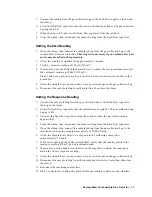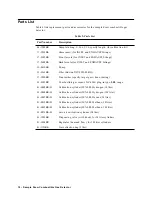
10 • Sample Draw Combustible Gas Detector
Start Up
This section describes procedures to start up the sample draw combustible gas detector
and place the sample draw detector into normal operation.
Introducing Incoming Power
1. Complete the installation procedures described earlier in this manual.
2. Verify that the power/device wiring is correct and secure.
3. Turn on or plug in the incoming power at the power source end.
4. Verify that the Pilot light is on.
5. Verify that the flowmeter indicates a flow rate of approximately 1.5 SCFH. If
necessary, use the bypass valve or flow adjust potentiometer to adjust the flow rate.
NOTE:
The following step tests for leaks in the sample line. This test may cause a low
flow condition at the sample draw detector.
6. Verify that the incoming sample line is not leaking. To test the sample line, plug the
open end of the sample line with your thumb. If the flowmeter ball drops to the
bottom of the flowmeter, the incoming sample line is not leaking.
7. Remove your thumb from the sample line, verify the flowmeter returns to a normal
flow rate.
Setting the Zero Reading
CAUTION:
If you suspect the presence of combustible gas in the monitoring environment, use
the calibration kit and the zero air calibration cylinder to introduce “fresh air” to the
sensor and verify an accurate zero setting.
1. Verify that the sample draw detector is sampling a fresh air environment
(environment known to be free of combustible gas).
2. Open the housing door.
3. Set a voltmeter to measure in the milivolt (mV) range.
4. Plug the voltmeter leads into the test points on the amplifier. Plug the positive lead
into the test point labeled
TP+
; plug the negative lead into the test point labeled
TP-
.
5. Verify a voltmeter reading of 100 mV (
±
2 mV).
6. If necessary, use a small flat-blade screwdriver to adjust the zero potentiometer until
the voltmeter reading is 100 mV (
±
2 mV).
7. Close the housing door.


















